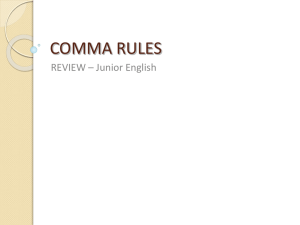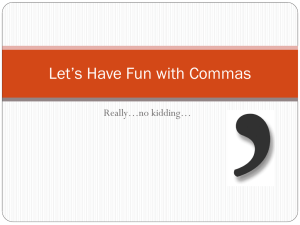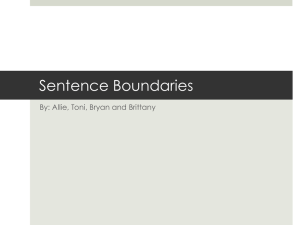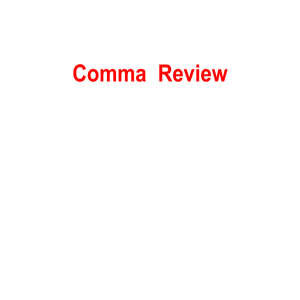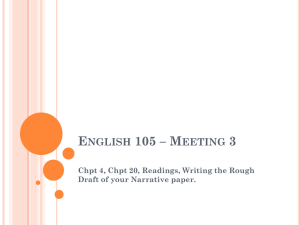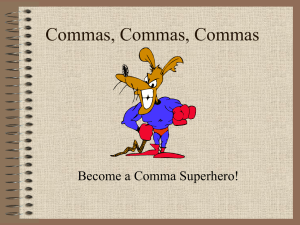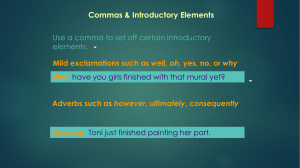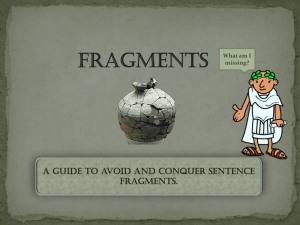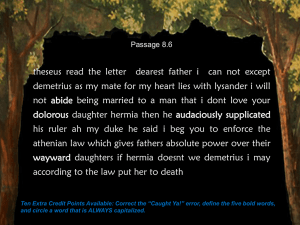Commas - Gordon State College
advertisement
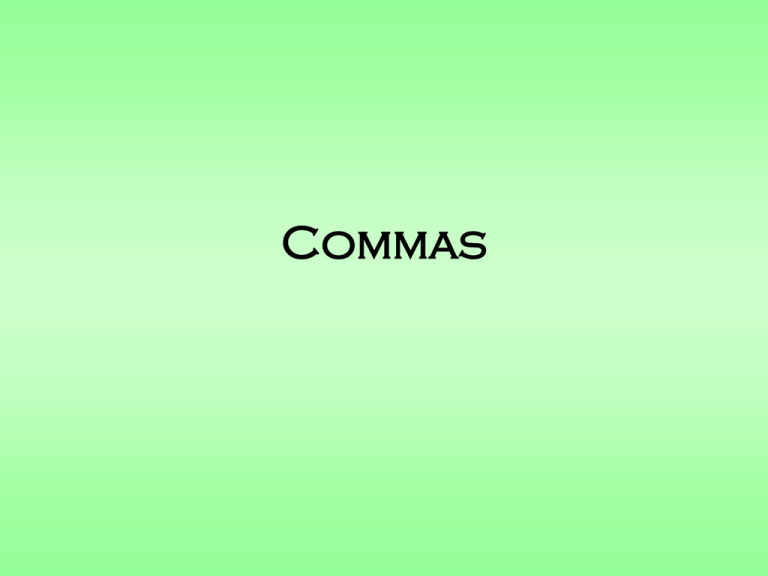
Commas There are lots of rules for using commas, as you might imagine. And there’s a good reason that studying commas comes after grammar study. The first usage mentioned below will be using commas after introductory adverbial clauses. Even if you don’t understand that right away, you will after you see an example. After he does the housework, he reads. Now you know what is meant by an introductory adverbial clause. But would you have been completely clear about that, even after an example, if you’d studied commas before you studied clauses? You have to understand sentence structure before you can understand punctuation. 1. COMMAS AFTER INTRODUCTORY ELEMENTS A. Use a comma after an introductory adverbial clause: Whenever he ate, he dropped food. If you try hard, you’ll succeed. Because I could not stop for death, he kindly stopped for me. B. Use a comma after introductory participial & infinitive phrases: Laughing at the monkey, the girl dropped her popcorn. To make good grades, you have to work hard. Let’s see if your brain is in good shape: why would it be absolutely incorrect to put a comma after the following infinitive phrase: To retire and travel is a dream I have. Answer: “To retire and travel” is a NOUN phrase functioning as the subject of the sentence. You don’t put a comma after NOUN phrases, only ADJECTIVE phrases. C. Use a comma after introductory prepositional phrases that have 5 words or more. This rule has a little flexibility. It could be 4 words; it could be 3 pretty long words. Under the spreading chestnut tree, her boyfriend proposed. Behind the new building, the boys were smoking. Through incredible darkness, he could see her face. In 1970 he wrote his second book. For good luck he carried a rabbit’s foot. You need a comma after even a short phrase if it prevents confusion: In the spring classes seem shorter. Since “spring” sometimes modifies classes, reading this sentence without a comma could be confusing. Put a comma after “spring” to clarify & make reading easier D. Other introductory elements Put a comma after introductory adverbs that modify the entire sentence: Fortunately, we have enough money. What’s fortunate? The whole idea that we have enough money. Unbelievably, the girl turned him down. What’s unbelievable? The whole idea that the girl turned him down. If the adverb modifies the verb, don’t use a comma: Slowly he walked down the hill. “Slowly” describes “walked,” not the whole sentence. Calmly he explained the problem. “Calmly” describes “explained,” not the whole sentence. 2. Put a comma before a coordinating conjunction that joins 2 independent clauses: I left early, but I still arrived late. She laughed at my accident, and then she fell down. Note that there is a complete independent clause (subjectverb) before the comma/conjunction & a complete independent clause after. You WOULDN’T use a comma if you aren’t combining complete independent clauses: He ran and laughed.– compound verb Jack and Jill ran up the hill. – compound subject He crawled under the table and down the stairs – compound prepositional phrases She made supper because she was hungry. – “Because” is a subordinating conjunction, not a coordinating conjunction. The comma rule works only with coordinating conjunctions (and, but, or, nor, for, so, yet). 3. Put a comma between 3 or more items in a series: I like chocolate, caramel, and strawberry. She runs, jumps, and wrestles. I don’t want to hear anything bad, sad, or angry. The last comma, the one before the coordinating conjunction, is optional. 4. Put commas around parenthetical elements. George Washington, the first president of the U.S., chopped down a cherry tree. His wife, on the other hand, once planted a cherry tree. Parenthetical elements are words/phrases/ clauses that can be taken out of the sentence because it isn’t essential to the meaning. 5. Put a comma between the day & year in a date & between a city & state; also, when these items are not the last word in a sentence, put a comma after the year & after the state: Today is May 1, 2013. I live in Barnesville, Georgia. Pay close attention here: I’m sure that May 1, 2013, was a Wednesday. I lived in Bristol, Virginia, for 18 years. The above examples should clarify the explanation at the top of the page. Most people aren’t aware of the need for a comma after the state & after the year when those elements aren’t the end of a sentence. 6. Use a comma to separate coordinate adjectives sometimes. The rich, good-looking man is single. My tall, intelligent friend knows him. BUT The little old lady is from Pasadena. The little gray car is mine. A rule that usually works is that if you could put an “and” between the two, you need a comma: The rich and good-looking man is single. That sounds better without the “and,” but it’s still OK with it. BUT The little and old lady is from Pasadena doesn’t work at all. 7. Use commas to set off quotes: Addison said, “Don’t touch my scrubs.” “Don’t touch my scrubs,” Addison said. “Don’t touch my scrubs,” Addison said, “or you’ll regret it.” However, if you’re making your quote part of your statement, don’t use a comma: In his paper on linguistic development, the author claims that Spanish “became a distinct language in the 9th century.” 8. Finally: sometimes you need a comma to prevent confusion. Sometimes there’s a natural pause that doesn’t seem to fit any rules, but you want to use a comma to reflect the pause. You can’t use the explanation that “it sounds better,” & when in doubt, stick to the rules. You’re not allowed to break the rules until you’ve mastered them. Comma exercises For exercises designed specifically for this class, go to Commas & Commas 2. Practice 1 Practice 2 Practice 3 Practice 4 Practice 5 Practice 6 Practice 7 Practice 8 Practice 9 Practice 10 Practice 11 Link to 8 fairly easy exercises. Practice 12 Practice 13 Practice 14 Practice 15 good, thorough
